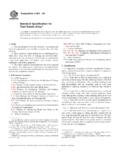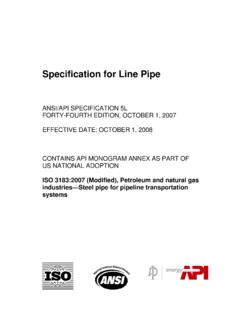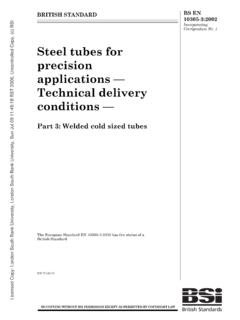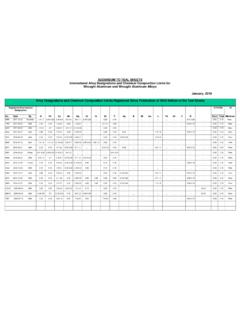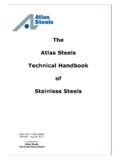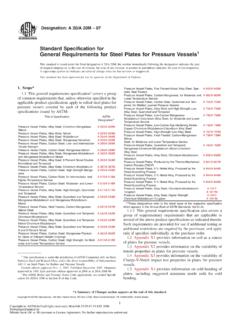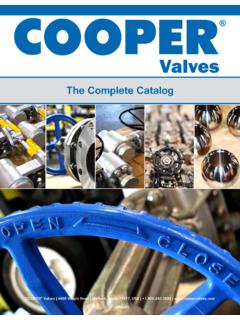Transcription of Standard Specification for Steel Bars, Alloy, …
1 Designation: A 322 91 (Reapproved 2001)e1. Standard Specification for Steel bars , Alloy, Standard Grades1. This Standard is issued under the fixed designation A 322; the number immediately following the designation indicates the year of original adoption or, in the case of revision, the year of last revision. A number in parentheses indicates the year of last reapproval. A. superscript epsilon (e) indicates an editorial change since the last revision or reapproval. This Standard has been approved for use by agencies of the Department of Defense. e1 NOTE A correction was made to Table 1 in May 2004. 1. Scope E 527 Practice for Numbering Metals and alloys (UNS)4. This specification covers hot-wrought alloy Steel bars . 3. Ordering Information Bar applications include forging, heat treating, cold drawing, machining and many structural components (Note 1).
2 Orders under this specification should include the fol- lowing as required to describe adequately the desired material: NOTE 1 A guide for the selection of Steel bars is contained in Practice Quantity (weight or number of bars ), A 400. Name of material (hot-wrought alloy Steel bars ), The bars shall be furnished in the grades specified in Dimensions, Table 1. Sections and sizes of bar Steel available are covered in ASTM designation, Specification A 29/A 29M. Hot-wrought alloy Steel bars are Deoxidation practice (see ), produced in cut lengths and coils; the manufacturer should be Grade designation or chemical composition limits (see consulted regarding sections and sizes available in coils, and Table 1), produced to a chemical composition. Grain size if required, Some applications may require superior surface quality, Test reports, if required (Section 8), or special chemical restrictions, metallurgical characteristics, Additions to the specification and Supplementary heat treatment, or surface finishes which the purchaser may Requirements, if required, and obtain by designating one or more of the available Supplemen- Application.
3 Tary Requirements. The values stated in inch-pound units are to be regarded 4. General Requirements as the Standard . Material furnished under this specification shall con- form to the applicable requirements of the current edition of 2. Referenced Documents Specification A 29/A 29M, unless otherwise provided herein. ASTM standards : A 29/A 29M Specification for Steel bars , Carbon and Alloy, 5. Materials and Manufacture Hot-Wrought and Cold-Finished, General Requirements The Steel shall be made by one or more of the following for2 primary processes: open-hearth, basic-oxygen, or electric- A 304 Specification for Steel bars , Alloy, Subject to End- furnace. The primary melting may incorporate separate degas- Quench Hardenability Requirements2 sing or refining and may be followed by secondary melting A 400 Practice for Steel bars , Selection Guide, Composi- using electro-slag remelting or vacuum arc remelting.
4 Where tion, and Mechanical Properties2 secondary melting is employed, the heat shall be defined as all E 112 Test Methods for Determining Average Grain Size3 of the ingots remelted from a single primary heat. E 381 Method of Macroetch Testing, Inspection, and Rating The Steel shall be furnished as strand cast or ingot cast, Steel Products, Comprising bars , Billets, Blooms, and unless otherwise specified. Forgings3 Deoxidation Killed Steel is required. The purchaser may designate that the Steel be made to coarse or fine austenitic grain size. (See Supplementary Re- 1. This specification is under the jurisdiction of ASTM Committee A01 on Steel , quirement S9 or S10.). Stainless Steel , and Related alloys and is the direct responsibility of Subcommittee Slow Cooling Immediately after hot forming, the bars on bars . shall be allowed to cool to a temperature below the critical Current edition approved Aug.
5 15, 1991. Published October 1991. Originally published as A 322 47 T. Last previous edition A 322 90b. 2. Annual Book of ASTM standards , Vol 3 4. Annual Book of ASTM standards , Vol Annual Book of ASTM standards , Vol Copyright ASTM International, 100 Barr Harbor Drive, PO Box C700, West Conshohocken, PA 19428-2959, United States. 1. A 322 91 (2001)e1. range under suitable conditions to prevent imperfections 6. Chemical Composition caused by too rapid cooling. The heat analysis shall conform to the requirements for Thermal Treatment Various thermal treatments such as chemical composition in Table 1 for the grade specified. annealing, stress relief, quench and temper, normalize, etc., are available. Such treatments must be specified as a Supplemen- tary Requirement. TABLE 1 Grade Designations and Chemical Compositions of Hot-Wrought Alloy Steel BarsA,B.
6 UNS GradeD Chemical Composition, Ranges and Limits, %. DesignationC Designations Carbon Manganese Phospho- Sulfur,E SiliconF Nickel Chromium Molybdenum rus, max max G13300 1330 .. G13350 1335 .. G13400 1340 .. G13450 1345 .. G40230 4023 .. G40240 4024 .. G40270 4027 .. G40280 4028 .. G40370 4037 .. G40470 4047 .. G41180 4118 .. G41200 .. G41210 .. G41300 4130 .. G41370 4137 .. G41400 4140 .. G41420 4142 .. G41450 4145 .. G41470 4147 .. G41500 4150 .. G41610 4161 .. G43200 4320 G43400 4340 G43406 E4340 G46150 4615 .. G46200 4620 .. G46210 4621 .. G46260 4626 .. G47150 G47200 4720 G48150 4815 .. G48170 4817 .. G48200 4820 .. G51170 5117 .. G51200 5120 .. G51300 5130 .. G51320 5132 .. G51350 5135 .. G51400 5140 .. G51500 5150 .. G51550 5155 .. G51600 5160 .. G51986 E51100 .. G52986 E52100 .. Vanadium G61180 6118 .. G61500 6150 .. min Molybdenum G86150 8615 G86170 8617 G86200 8620 G86220 8622 G86250 8625 G86270 8627 G86300 8630 G86370 8637 G86400 8640 G86420 8642 2.
7 A 322 91 (2001)e1. TABLE 1 Continued D. UNS Grade Chemical Composition, Ranges and Limits, %. DesignationC Designations Carbon Manganese Phospho- Sulfur,E SiliconF Nickel Chromium Molybdenum rus, max max G86450 8645 G86550 8655 G87200 8720 G87400 8740 G88220 8822 G92590 9259 .. G92600 9260 .. Standard Boron SteelsG. G50441 50B44 .. G50461 50B46 .. G50501 50B50 .. G50601 50B60 .. G51601 51B60 .. G81451 81B45 G94171 94B17 G94301 94B30 A. Small quantities of certain elements are present in alloy steels which are not specified or required. These elements are considered as incidental and may be present to the following maximum amounts: copper %, nickel %, chromium %, and molybdenum %. B. Standard alloy steels can be produced with a lead range of to %. Such steels are identified by inserting the letter L between the second and third numerals of the number, that is, 41L40.
8 A cast or heat analysis is not determinable when lead is added to the ladle stream C. New designation established in accordance with Practice E 527. D. Grade designations correspond to the respective AISI and SAE designations. Grade compositions correspond to the respective AISI compositions. E. Where minimum and maximum sulfur contents are shown, it is indicative of resulfurized Steel F. Silicon may be specified by the purchaser as % maximum. The need for % maximum generally relates to severely cold-formed parts. G. These steels can be expected to contain to boron %. If the usual titanium additive is not permitted, the steels can be expected to contain up to boron. The composition of the Steel furnished under this 8. Certification and Test Reports specification may be other than listed in Table 1 when agreed When specified by the purchaser, a manufacturer's upon between the manufacturer and the purchaser as out-lined certification that the material was manufactured and tested in in Specification A 29/A 29M (Table on Heat Analysis Chemi- accordance with this specification, together with a report of the cal Ranges and Limits of Alloy Steel bars ).
9 Cast or heat analysis test results for the specified elements, shall 7. Workmanship, Finish, and Appearance be furnished. The report shall include the name of the manu- Workmanship The bars shall be free of pipe, cracks, facturer, ASTM designation and year date and revision letter, if and flakes. Within the limits of good manufacturing and any, type and grade, heat number, and size. inspection practices, the bars shall be free of injurious seams, When Supplementary Requirements are specified, the laps, segregation, or other imperfections which due to their report shall include a statement of compliance with the nature, degree, or extent, will interfere with the use of the requirement of the results of tests when the requirement material in machining or fabrication of suitable parts. involves measured test values. Descaling When descaled bars are required, Supple- mentary Requirement S12 on Pickling or S13 on Blast Clean- ing must be specified.
10 SUPPLEMENTARY REQUIREMENTS. One or more of the following Supplementary Requirements shall apply when specified by the purchaser. S1. Axle Shaft Quality S2. Ball and Roller Bearing Quality and Bearing Quality Axle shaft quality applies to hot-rolled Steel bars This quality applies to Steel intended for antifriction intended for the manufacture of power-driven axle shafts of the bearings. automotive or truck type, which by their design or method of manufacture are not machined all over or have less than S3. Cold Shearing Quality recommended stock removed for the proper clean-up of normal When the bar size exceeds certain limits, it is recom- surface imperfections. mended that cold shearing quality Steel be ordered. This quality 3. A 322 91 (2001)e1. will provide characteristics which permit cold shearing without S8. Stress Relieving cracking. The producer should be consulted in establishing the The Steel shall be stress relieved by heating to a proper practice.
